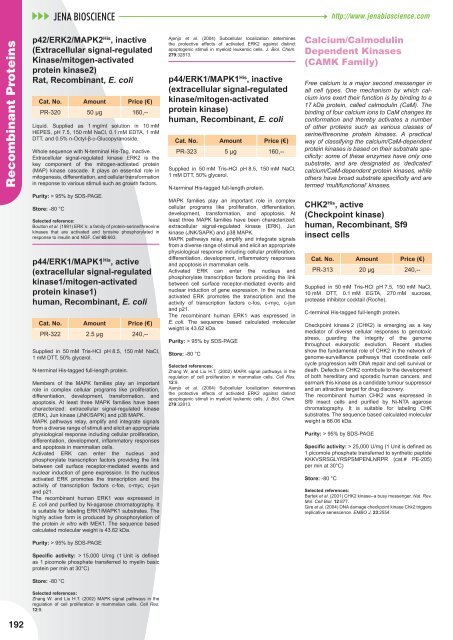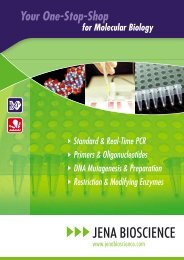Nucleotide Analogs - Jena Bioscience
Nucleotide Analogs - Jena Bioscience
Nucleotide Analogs - Jena Bioscience
You also want an ePaper? Increase the reach of your titles
YUMPU automatically turns print PDFs into web optimized ePapers that Google loves.
Recombinant Proteins<br />
192<br />
p42/ERK2/MAPK2 His , inactive<br />
(Extracellular signal-regulated<br />
Kinase/mitogen-activated<br />
protein kinase2)<br />
Rat, Recombinant, E. coli<br />
Cat. No. Amount Price (€)<br />
PR-320 50 µg 160,--<br />
Liquid. Supplied as 1 mg/ml solution in 10 mM<br />
HEPES, pH 7.5, 150 mM NaCl, 0.1 mM EDTA, 1 mM<br />
DTT, and 0.5% n-Octyl-β-D-Glucopyranoside.<br />
Whole sequence with N-terminal His-Tag, inactive.<br />
Extracellular signal-regulated kinase ERK2 is the<br />
key component of the mitogen-activated protein<br />
(MAP) kinase cascade. It plays an essential role in<br />
mitogenesis, differentiation, and cellular transformation<br />
in response to various stimuli such as growth factors.<br />
Purity: > 95% by SDS-PAGE.<br />
Store: -80 °C<br />
Selected reference:<br />
Boulton et al. (1991) ERK´s: a family of protein-serine/threonine<br />
kinases that are activated and tyrosine phosphorylated in<br />
response to insulin and NGF. Cell 65:663.<br />
p44/ERK1/MAPK1 His , active<br />
(extracellular signal-regulated<br />
kinase1/mitogen-activated<br />
protein kinase1)<br />
human, Recombinant, E. coli<br />
Cat. No. Amount Price (€)<br />
PR-322 2.5 µg 240,--<br />
Supplied in 50 mM Tris-HCl pH 8.5, 150 mM NaCl,<br />
1 mM DTT, 50% glycerol.<br />
N-terminal His-tagged full-length protein.<br />
Members of the MAPK families play an important<br />
role in complex cellular programs like proliferation,<br />
differentiation, development, transformation, and<br />
apoptosis. At least three MAPK families have been<br />
characterized: extracellular signal-regulated kinase<br />
(ERK), Jun kinase (JNK/SAPK) and p38 MAPK.<br />
MAPK pathways relay, amplify and integrate signals<br />
from a diverse range of stimuli and elicit an appropriate<br />
physiological response including cellular proliferation,<br />
differentiation, development, infl ammatory responses<br />
and apoptosis in mammalian cells.<br />
Activated ERK can enter the nucleus and<br />
phosphorylate transcription factors providing the link<br />
between cell surface receptor-mediated events and<br />
nuclear induction of gene expression. In the nucleus<br />
activated ERK promotes the transcription and the<br />
activity of transcription factors c-fos, c-myc, c-jun<br />
and p21.<br />
The recombinant human ERK1 was expressed in<br />
E. coli and purifi ed by Ni-agarose chromatography. It<br />
is suitable for labeling ERK1/MAPK1 substrates. The<br />
highly active form is produced by phosphorylation of<br />
the protein in vitro with MEK1. The sequence based<br />
calculated molecular weight is 43.62 kDa.<br />
Purity: > 95% by SDS-PAGE<br />
Specifi c activity: > 15,000 U/mg (1 Unit is defi ned<br />
as 1 picomole phosphate transferred to myelin basic<br />
protein per min at 30°C)<br />
Store: -80 °C<br />
Selected references:<br />
Zhang W. and Liu H.T. (2002) MAPK signal pathways in the<br />
regulation of cell proliferation in mammalian cells. Cell Res.<br />
12:9.<br />
Ajenjo et al. (2004) Subcellular localization determines<br />
the protective effects of activated ERK2 against distinct<br />
apoptogenic stimuli in myeloid leukemic cells. J. Biol. Chem.<br />
279:32813.<br />
p44/ERK1/MAPK1 His , inactive<br />
(extracellular signal-regulated<br />
kinase/mitogen-activated<br />
protein kinase)<br />
human, Recombinant, E. coli<br />
Cat. No. Amount Price (€)<br />
PR-323 5 µg 160,--<br />
Supplied in 50 mM Tris-HCl pH 8.5, 150 mM NaCl,<br />
1 mM DTT, 50% glycerol.<br />
N-terminal His-tagged full-length protein.<br />
MAPK families play an important role in complex<br />
cellular programs like proliferation, differentiation,<br />
development, transformation, and apoptosis. At<br />
least three MAPK families have been characterized:<br />
extracellular signal-regulated kinase (ERK), Jun<br />
kinase (JNK/SAPK) and p38 MAPK.<br />
MAPK pathways relay, amplify and integrate signals<br />
from a diverse range of stimuli and elicit an appropriate<br />
physiological response including cellular proliferation,<br />
differentiation, development, infl ammatory responses<br />
and apoptosis in mammalian cells.<br />
Activated ERK can enter the nucleus and<br />
phosphorylate transcription factors providing the link<br />
between cell surface receptor-mediated events and<br />
nuclear induction of gene expression. In the nucleus<br />
activated ERK promotes the transcription and the<br />
activity of transcription factors c-fos, c-myc, c-jun<br />
and p21.<br />
The recombinant human ERK1 was expressed in<br />
E. coli. The sequence based calculated molecular<br />
weight is 43.62 kDa.<br />
Purity: > 95% by SDS-PAGE<br />
Store: -80 °C<br />
Selected references:<br />
Zhang W. and Liu H.T. (2002) MAPK signal pathways in the<br />
regulation of cell proliferation in mammalian cells. Cell Res.<br />
12:9.<br />
Ajenjo et al. (2004) Subcellular localization determines<br />
the protective effects of activated ERK2 against distinct<br />
apoptogenic stimuli in myeloid leukemic cells. J. Biol. Chem.<br />
279:32813.<br />
http://www.jenabioscience.com<br />
Calcium/Calmodulin<br />
Dependent Kinases<br />
(CAMK Family)<br />
Free calcium is a major second messenger in<br />
all cell types. One mechanism by which calcium<br />
ions exert their function is by binding to a<br />
17 kDa protein, called calmodulin (CaM). The<br />
binding of four calcium ions to CaM changes its<br />
conformation and thereby activates a number<br />
of other proteins such as various classes of<br />
serine/threonine protein kinases. A practical<br />
way of classifying the calcium/CaM-dependent<br />
protein kinases is based on their substrate specifi<br />
city: some of these enzymes have only one<br />
substrate, and are designated as ‘dedicated’<br />
calcium/CaM-dependent protein kinases, while<br />
others have broad substrate specifi city and are<br />
termed ‘multifunctional’ kinases.<br />
CHK2 His , active<br />
(Checkpoint kinase)<br />
human, Recombinant, Sf9<br />
insect cells<br />
Cat. No. Amount Price (€)<br />
PR-313 20 µg 240,--<br />
Supplied in 50 mM Tris-HCl pH 7.5, 150 mM NaCl,<br />
10 mM DTT, 0.1 mM EGTA, 270 mM sucrose,<br />
protease inhibitor cocktail (Roche).<br />
C-terminal His-tagged full-length protein.<br />
Checkpoint kinase 2 (CHK2) is emerging as a key<br />
mediator of diverse cellular responses to genotoxic<br />
stress, guarding the integrity of the genome<br />
throughout eukaryotic evolution. Recent studies<br />
show the fundamental role of CHK2 in the network of<br />
genome-surveillance pathways that coordinate cellcycle<br />
progression with DNA repair and cell survival or<br />
death. Defects in CHK2 contribute to the development<br />
of both hereditary and sporadic human cancers, and<br />
earmark this kinase as a candidate tumour suppressor<br />
and an attractive target for drug discovery.<br />
The recombinant human CHK2 was expressed in<br />
Sf9 insect cells and purifi ed by Ni-NTA agarose<br />
chromatography. It is suitable for labeling CHK<br />
substrates. The sequence based calculated molecular<br />
weight is 66.06 kDa.<br />
Purity: > 95% by SDS-PAGE<br />
Specifi c activity: > 25,000 U/mg (1 Unit is defi ned as<br />
1 picomole phosphate transferred to synthetic peptide<br />
KKKVSRSGLYRSPSMPENLNRPR (cat.# PE-205)<br />
per min at 30°C)<br />
Store: -80 °C<br />
Selected references:<br />
Bartek et al. (2001) CHK2 kinase--a busy messenger. Nat. Rev.<br />
Mol. Cell Biol. 12:877.<br />
Gire et al. (2004) DNA damage checkpoint kinase Chk2 triggers<br />
replicative senescence. EMBO J. 23:2554.



